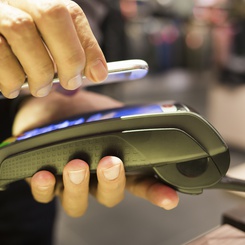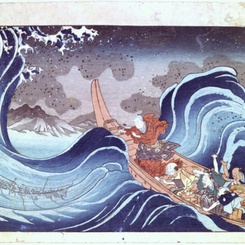As the manufacturers of two of the most talked about mobile devices, Apple and Samsung are the clear leaders of the smartphone industry in terms of hardware: new generations of their respective iPhone and Galaxy handsets are always hotly anticipated and almost systematically fawned over by media. Yet while Apple devices operate exclusively on their own operating system (iOS), Samsung offers smartphones running different operating systems, with most users opting for the Google Android operating system.
This situation may be set to change: During an interview on March 15th, Samsung CEO Lee Kun-Hee announced the company’s intentions to release hardware operating on Tizen OS – Samsung’s own open-sourced operating system – as early as this August.
One could imagine this would be a logical next step for such a huge player in the mobile industry as this could be Samsung’s chance to free itself from dependence on Google. But forJan Ondrus, when gauging this potential success or failure of such a move, a lot will depend on Samsung’s intended market.
Samsung hasn’t yet been clear on this front. If the new platform simply builds on its pre-existing Bada OS, staying focused on the same low to mid-range market, Tizen may indeed be able to carve out a successful niche for itself by offering something relatively new: a strong, entry-level operating system. That said, Lee Kun-Hee’s statements would appear to suggest that Tizen will be aimed at high-end devices, putting Tizen OS in direct competition with Android.
Trying to impose a new mobile operating system in an already saturated market doesn’t make much business sense for Samsung, says Professor Ondrus.
Indeed, four major operating systems already coexist: Google Android and Apple iOS clearly dominate – representing together more than 90% of the Smartphone market worldwide – while Windows and Blackberry struggle to maintain their footing. iOS and Android dominate in part thanks to the strength of their respective ecosystems – that is to say the extent to which their hardware devices work well with each other and the array of applications and content available to their users.
The All-Mighty App
There was a time when customers weren’t expecting much in terms of software applications and were happy with what would today be considered the bare minimum. When the first generations of the iPhone hit stores, consumers wanted make phone calls, send text messages, add events to their calendar, browse webpages, and eventually listen to their music library while on the move. They really had limited expectations beyond these few basic tools.
Today, users expect a lot of their smartphone’s software. In fact, the software component has become critical for operating systems, with the number of available applications reflecting an operating system’s health and market penetration: Android and iOS each boast 700 000 applications to Microsoft Windows Phone’s 120 000, which highlights Microsoft’s current struggles.
Only three years ago Android had 9 000 apps to Apple’s 100 000 and yet they managed to more or less catch-up in the span of only a few months. But according to Professor Ondrus, Android was able to catch-up to iOS because there was still room for a contender to grow in the market.
“It’s now very late in the game and I think even a powerful brand like Samsung will have trouble creating a software ecosystem that will be able to compete with the App Store and Google Play. Growth rates for both the iOS and Android are beginning to level off. The market is far more saturated and I’m doubtful that Samsung will be able to experience the kind of growth that its two main competitors enjoyed.”
Meanwhile, the expense and/or hassle of switching to another platform locks customers into their respective ecosystems: once you have the hardware (a handset and tablet), a collection of applications and associated content including music files and more, you’re generally invested in your ecosystem for the long haul. Even if Samsung comes out with a very attractive offer and forge partnerships with businesses to create a healthy software ecosystem, it won’t necessarily be easy to seduce customers.
The Chicken-and-the-Egg Dilemma
“In Economics, this chicken-and-the-egg problem is well-known when it comes to launching what we call multi-sided platforms, which aim at facilitating interactions between multiple distinct group of users,” explains Professor Ondrus. “This is the dilemma that Samsung now faces. And to put it bluntly, if they fail to attract enough customers or developers simultaneously to support the ecosystem within a limited time-frame, the platform will die.”
In other words, customers won’t switch to a platform that doesn’t have the applications they want, and, simultaneously, developers won’t develop applications for a platform that doesn’t have enough customers. To illustrate the problem, Professor Ondrus cites the example of Palm Inc.’s unsuccessful attempt to enter the market with its WebOS: After four years of operations and with only 10 000 apps, the platform was discontinued as it failed to attract enough participants on both sides on the market.
Microsoft currently finds itself in a similar situation and in order to ensure key companies develop applications for its platform, it currently has to sponsor developer, paying between $60 000 to $600 000 for each application.[i] And although some popular applications are still missing from their roster, they do offer a substation 120 000 applications.
Microsoft’s situation in the mobile industry is a perfect illustration of what difficulties may lie ahead for Samsung. In fact, Samsung’s Tizen OS will find itself in a trickier position than Microsoft’s mobile operating system considering it doesn’t benefit from being part of a huge ecosystem like Windows who of course dominates the PC operating system market. And even heavily subsidized, Microsoft still only owns some 10% of the mobile market. The Windows Phone just can’t compete with the Android and iOS giants who have no trouble proving to developers that their applications will be seen and downloaded. Why would a developer create an applications for a platform they don’t believe is viable and profitable for themselves? And if Microsoft are struggling, what will make Tizen any different? That is what remains to be seen.
Come August, this will be a sensitive transition for Samsung. If the switch is too abrupt, Samsung may see their market share impacted, with consumers choosing to stay with the well-established Android ecosystem in which they have already invested.
“I really believe the only hope for Samsung’s Tizen OS,” concludes professor Ondrus, “would be for them to bring a completely new value proposition to consumers who would accept a compromise on the low number of apps available at launch. The trouble is, Tizen doesn’t seem to want to differentiate itself much from the existing mobile platforms. Working within a saturated market, Samsung will only have a limited amount of time to build its ecosystem and attract customers. Regardless of the strength of the Samsung brand today, without this critical mass, Tizen is doomed to failure.”
[i] Gralla, Preston,“Microsoft subsidizes developers up to $600,000 per Windows Phone app”, Computerworld, April 6, 2012.









